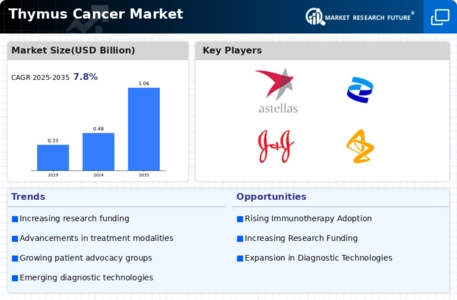Drivers
Thymus cancer's increased prevalence is projected to fuel Thymus Cancer Market Trends. Furthermore, growing oncology research and development expenditures for the development of novel cancer treatments are likely to promote Market Growth. The growing desire for technical improvements, innovative therapies, and more government initiatives are the key driving forces. For less than, 1andn the thymus, Thymoma is quite ranting. Thymoma and thymic carcinoma are more common in adults aged 40 to 60, but they can happen at any age. As a result, the market is expected to rise as the population ages.
During surgery, the majority of the thymus is diagnosed, staged, and treated. Advancements in cancer treatments and therapies may be the Thymus Cancer Market Growth driving force.
Restraints
The treatment's negative effects and the government's strict rules are projected to stifle Thymus Cancer Market Outlook. Because thymus cancer is such an uncommon type of cancer, there are few studies on its risk factors and likely causes, which can be a disadvantage for the thymus cancer market in terms of diagnosis. The high expense of thymus cancer therapy, on the other hand, is anticipated to limit the size. Radiation, for example, can damage the bone marrow, resulting in low blood levels, according to the American Cancer Society.
Anemia (low red blood cell counts) and low white blood cell counts can result, increasing the risk of serious infections. Chest radiation therapy for the lungs is also an option. This can cause respiratory problems and shortness of breath. This normally improves when the radiation treatments finish, although the damage can sometimes be permanent (or even permanent). As a result, the emergence of adverse effects is likely to stymie the market Share.
The Thymus Cancer market has a lot of potential thanks to technological advancements and advanced research. Companies are concentrating on thymus cancer diagnosis treatments as well as innovative remedies. Thymus malignancies are currently identified using a variety of techniques such as chest X-rays, CT scans, PET scans, needle biopsy, MRI scans, thoracoscopy, and mediastinoscopy. Additionally, surgery and chemotherapy are the primary therapeutic choices for thymus cancer excision. Clinical trials for the treatment of thymus cancer are also underway.
Thymus Cancer Market Segmentation
Thymus Cancer cancer type Outlook
Thymoma
Thymic Carcinoma
Thymus Cancer treatment type Outlook
Chemotherapy
Surgery
Radiation Therapy
Others
Thymus Cancer end-user Outlook
Hospitals & Clinics
Research & Academic Institutes
Others
Thymus Cancer Market Regional Classification
Because of the increased occurrence of thymus cancer, the Americas are likely to lead the worldwide thymus cancer market.
Due to the presence of significant market participants such as AstraZeneca, Novartis AG, and others, Europe is likely to hold the second-largest share of the market.
Due to rising awareness of various types of cancer, including thymus cancer, rising incidence rates of thymus cancer, and increased R&D in the field of oncology, Asia-Pacific is predicted to be the fastest-growing regional market.
Due to a lack of awareness about the disease, the thymus cancer market in the Middle East and Africa is likely to develop slowly throughout the forecast period.
Americas
North America
US
Canada
Latin America
Europe
Western Europe
Germany
France
Italy
Spain
UK
Rest of Western Europe
Eastern Europe
Asia-Pacific
Japan
China
India
Australia
South Korea
Rest of Asia-Pacific
The Middle East & Africa
Middle East
Africa
Thymus Cancer Market Competitive Landscape
Amgen Inc. (US),
Astellas Pharma Inc. (Japan)
Eli Lilly and Company (US)
Merck & Co., Inc. (the US)
Novartis AG (Switzerland)
Celgene Corporation (US)
Pfizer Inc. (US)
Mylan NV (US)
Johnson & Johnson Services, Inc. (the US)
Onxeo (France)
Bristol-Myers Squibb Company (US)
Boston Biomedical, Inc. (the UK)
AstraZeneca (UK)
Takeda Pharmaceutical Company Limited (Japan)
Tiziana Life Sciences plc (UK)
Teva Pharmaceutical Industries Ltd (Israel)
Product launches, mergers and acquisitions, partnerships, and collaborations are among the methods used by key competitors to contribute to the global growth of the thymus cancer market. The major parties are expected to collaborate on the purchasing volume, prices, pricing analysis, and regulatory framework, among other major highlights. Manufacturing structure and distribution routes are covered. During the projected period, this is expected to generate possibilities for the Thymus Cancer market to develop.
Recent Developments New research evaluating the investigational compound napabucasin in the treatment of multiple tumors, including advanced gastric and gastroesophageal junction adenocarcinoma, metastatic pancreatic adenocarcinoma, and advanced thymoma and thymic carcinoma, was presented by Boston Biomedical, Inc. The International Thymic Malignancy Interest Group is a non-profit organization whose mission is to develop clinical and basic science in the field of thymic and other mediastinal malignancies and related disorders.
Report Overview The Global Thymus Cancer Market research includes detailed information on emerging trends, market drivers, technological analysis, and market constraints that may affect the industry's market dynamics. It includes types, applications, and competitor analyses in its in-depth research of market segments. The study examines consumer and technological trends in specific regions, as well as the most recent industry dynamics. The study examines the many forces influencing market dynamics, as well as essential and related industries, and assists businesses in understanding various customer propositions. This intelligence report is the result of extensive research and analysis of the different factors that influence market growth.
The Global Thymus Cancer Market is poised for growth, driven by advancements in targeted therapies and an increasing understanding of the disease's molecular underpinnings.
National Cancer Institute














